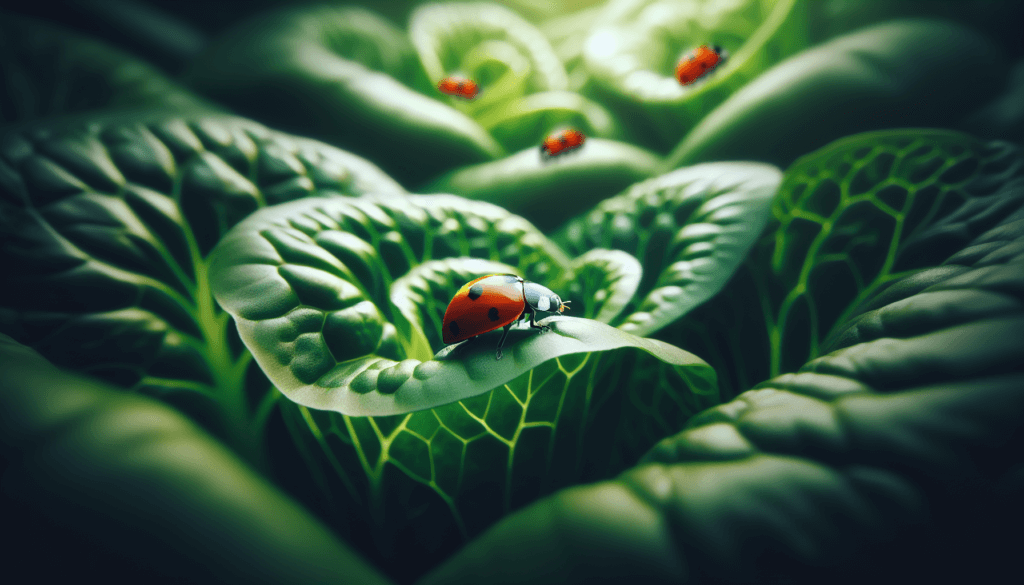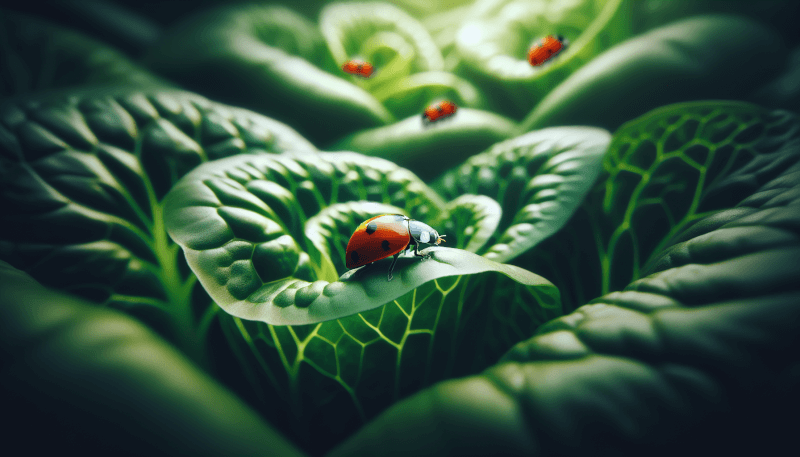In the world of urban gardening, keeping pesky pests at bay can be a challenge. However, with a few simple tips and tricks, you can ensure a thriving garden without the headache of unwanted intruders. From natural deterrents to pest-resistant plant varieties, this article will guide you through the best practices for pest control in urban gardening. So roll up your sleeves, grab your gardening gloves, and get ready to create an oasis of green in the heart of the city.
Prevention Measures
Selection of resistant plant varieties
When it comes to pest control in urban gardening, one of the best prevention measures is to choose resistant plant varieties. These plants have natural defenses against common pests and are less likely to be attacked or damaged. By selecting plants that are known to be resilient, you can significantly reduce the risk of pest infestations in your garden. It is important to do some research and choose varieties that are specifically bred to be resistant to pests prevalent in your area.
Companion planting
Companion planting is another effective method for preventing pests in your urban garden. By strategically planting certain plants together, you can create a natural pest deterrent system. Some plants have properties that repel pests, while others may attract beneficial insects that prey on garden pests. For example, planting marigolds alongside tomato plants can help deter aphids, while attracting beneficial insects like ladybugs. Utilizing companion planting techniques can help create a balanced ecosystem in your garden and reduce the need for chemical pest control methods.
Proper soil preparation
Proper soil preparation is crucial for pest control in urban gardening. Healthy and well-drained soil provides a strong foundation for plants and helps them resist diseases and pests. It is important to regularly amend the soil with organic matter, such as compost, to improve its fertility and structure. This promotes the growth of strong and healthy plants that are less susceptible to pest attacks. Additionally, removing any weeds or debris from the soil can eliminate hiding places for pests and reduce the risk of infestations.
Regular maintenance and sanitation
Regular maintenance and sanitation practices are vital in preventing and controlling pests in urban gardens. It is important to regularly monitor your plants for signs of pests or diseases and take prompt action if any are detected. Removing any damaged or infected plant parts can help prevent the spread of pests and diseases. Additionally, keeping your garden clean and tidy by removing fallen leaves, debris, and weeds can eliminate potential habitats for pests. Regularly cleaning and disinfecting gardening tools can also help prevent the introduction of pests.
Natural Pest Control Methods
Biological control
Biological control involves the use of natural predators, parasites, or pathogens to control garden pests. This method relies on maintaining a balance between pests and their natural enemies. Some common examples of biological control include introducing ladybugs to control aphids or using nematodes to control soil-dwelling pests. By harnessing the power of nature, biological control methods can effectively reduce pest populations without the need for harmful chemicals.
Attracting beneficial insects
Attracting beneficial insects is another natural pest control method that can be employed in urban gardening. Many beneficial insects, such as lacewings, hoverflies, and parasitic wasps, feed on common garden pests. By providing these beneficial insects with suitable habitats and food sources, such as nectar-producing flowers and insectary plants, you can encourage them to reside in your garden and naturally control pests. Planting a diverse range of flowering plants throughout your garden can help attract and sustain beneficial insect populations.
Use of traps
Traps can be an effective tool for controlling and monitoring pests in urban gardening. Different types of traps can be used to target specific pests, such as sticky traps for flying insects or pitfall traps for ground-dwelling pests. Traps are particularly useful for monitoring pest populations, as they can help you determine the severity of an infestation and guide your pest control strategies. Traps can also be used as a means of physical control, as they can capture and remove pests from your garden environment.
Barriers and physical deterrents
Using barriers and physical deterrents can be an effective way to prevent pests from accessing your urban garden. For example, using floating row covers can help protect your plants from flying pests like aphids or whiteflies. Installing fences or netting can help keep larger pests, such as rabbits or birds, out of your garden. Physical deterrents, such as reflective tape or scare devices, can also help deter pests by creating visual or auditory disturbances. By creating physical barriers or employing deterrents, you can protect your garden from pest damage.

Organic Pest Control Solutions
Neem oil
Neem oil is a popular organic pest control solution that is derived from the seeds of the neem tree. It has insecticidal properties and can be effective against a wide range of garden pests, including aphids, caterpillars, and spider mites. Neem oil works by disrupting the feeding and reproductive systems of pests, ultimately leading to their demise. It is important to follow the instructions on the product label when using neem oil and to avoid applying it during peak pollination times to minimize any potential harm to beneficial insects.
Diatomaceous earth
Diatomaceous earth is a natural pest control solution that is made from the fossilized remains of microscopic algae. It contains sharp particles that can pierce the exoskeletons of insects, causing them to dehydrate and die. Diatomaceous earth can be an effective control method for pests like slugs, snails, and crawling insects. It can be applied directly to the soil or around plants to create a barrier. However, it is important to use food-grade diatomaceous earth and to avoid inhaling the dust, as it can be harmful to humans and pets if ingested or inhaled in large amounts.
Insecticidal soaps
Insecticidal soaps are formulated to kill soft-bodied insects, such as aphids, mealybugs, and whiteflies. These soaps work by breaking down the outer protective layer of the pests, causing them to dehydrate and die. Insecticidal soaps are generally considered safe for use on plants and do not leave behind harmful residues. However, it is important to apply the soap directly to the pests and to thoroughly coat the affected plant parts. It is also advisable to test the soap on a small area of the plant before applying it more broadly to ensure there are no adverse effects.
Plant-based repellents
Plant-based repellents can be a natural and effective way to deter pests from your urban garden. Certain plants contain compounds that repel or deter specific pests. For example, planting marigolds can help repel aphids, and planting mint can help repel ants. Additionally, aromatic herbs like rosemary or basil can help deter a variety of pests. By strategically incorporating these repellent plants throughout your garden, you can create a natural barrier against pests and reduce the need for chemical pesticides.
Integrated Pest Management (IPM)
Monitoring and identification
Monitoring and identifying pests is the first step in implementing integrated pest management (IPM) in your urban garden. Regularly inspecting your plants for signs of pest damage or infestations can help you identify the specific pests that are causing problems. It is important to familiarize yourself with the common pests in your area and their characteristics. This knowledge will allow you to take appropriate action and choose the most effective control methods.
Threshold determination
Once pests have been identified, it is important to determine the pest population threshold in your urban garden. The pest population threshold refers to the level at which pest populations become damaging to your plants. This threshold can vary depending on the type of plant, its growth stage, and your tolerance for pest damage. Understanding and setting a threshold will help you determine when control measures need to be implemented to prevent significant damage.
Implementing control measures
After monitoring and determining the pest population threshold, the next step in IPM is implementing control measures. IPM emphasizes the use of non-chemical control methods first, such as cultural practices or physical barriers. Only if non-chemical methods are not sufficient should targeted pesticide applications be considered. It is important to choose the appropriate control measures based on the type of pest, the plants being affected, and the severity of the infestation. Regular monitoring and evaluation of control measures will help ensure their effectiveness in managing pests.

Safe Chemical Pest Control Options
Targeted pesticide application
In some cases, targeted pesticide applications may be necessary to control pests in urban gardening. However, it is important to use pesticides judiciously and responsibly to minimize harm to the environment and beneficial insects. Targeted pesticide applications involve applying pesticides only to the affected plants or specific areas of your garden, rather than blanket spraying the entire garden. This targeted approach helps reduce pesticide exposure to non-target organisms and minimizes the risk of pesticide residues in your produce.
Use of eco-friendly pesticides
To promote safe chemical pest control in urban gardening, it is advisable to choose eco-friendly pesticides that have minimal impact on the environment and non-target organisms. These pesticides are often derived from natural sources, such as plant extracts or bacteria, and break down more quickly in the environment. It is important to carefully read and follow the instructions on the pesticide label to ensure proper use and avoid any negative consequences. Additionally, it is advisable to use eco-friendly pesticides as a last resort, after exhausting all non-chemical control options.
Proper application techniques
Proper application techniques are essential when using chemical pesticides in urban gardening. It is important to accurately measure and mix the pesticide according to the instructions on the label. Applying pesticides on a calm day can help minimize drift and prevent the unintended exposure of non-target organisms. It is also advisable to avoid applying pesticides during peak pollination times to reduce the risk of harming beneficial insects. Proper disposal of pesticide containers and following local regulations regarding pesticide use are also important aspects of safe chemical pest control.
Creating a Pest-Free Environment
Proper watering techniques
Proper watering techniques are crucial for maintaining a pest-free environment in your urban garden. Overwatering can create a damp and favorable environment for pests, such as slugs, snails, and certain fungal diseases. It is important to water your plants at the appropriate times and in the appropriate amounts. Watering in the morning allows the foliage to dry off during the day, preventing the growth of fungal pathogens. Additionally, watering at the base of plants rather than overhead can help minimize moisture on the leaves and deter pests.
Regular pruning and trimming
Regular pruning and trimming of plants can help create a pest-free environment in your urban garden. Removing dead or damaged plant parts can eliminate potential hiding places for pests and reduce the risk of diseases. Also, pruning can help improve airflow and light penetration, creating an unfavorable environment for certain pests and diseases. It is important to use clean and sterilized pruning tools to prevent the spread of diseases. Proper pruning practices can prevent and control pest infestations, resulting in healthier and more productive plants.
Weed control
Weed control is an important aspect of maintaining a pest-free environment in your urban garden. Weeds can host pests and provide hiding places and food sources for them. Controlling weeds through manual removal, mulching, or appropriate herbicide application can help eliminate potential habitats for pests. It is important to remove weeds regularly and as early as possible to prevent them from going to seed and spreading further. By keeping your garden weed-free, you can minimize competition for resources and reduce the risk of pest infestations.
Optimal lighting and shading
Creating optimal lighting and shading conditions is beneficial for both plants and pest control in urban gardening. Different plants have different light requirements, and providing them with the appropriate amount of light can promote healthy growth and reduce stress, making them less susceptible to pests and diseases. Additionally, shading certain plants can help protect them from intense heat or sunburn, which can weaken their defenses and make them more vulnerable to pests. Understanding the light preferences of your plants and providing suitable lighting and shading can contribute to a pest-free environment.

Dealing with Common Pests
Aphids
Aphids are one of the most common pests in urban gardening and can cause significant damage to a variety of plants. To control aphids, you can physically remove them by hand or with a strong stream of water. Additionally, attracting natural predators like ladybugs or lacewings can help keep aphid populations in check. Some organic pesticides, such as insecticidal soaps or neem oil, can also be effective against aphids. Regularly monitoring your plants for early signs of aphid infestations and taking prompt action can prevent their populations from escalating and causing extensive damage.
Whiteflies
Whiteflies are tiny, sap-sucking insects that can quickly multiply and infest your urban garden. Yellow sticky traps can be used to monitor and control whitefly populations. Beneficial insects like ladybugs and parasitic wasps also prey on whiteflies, so attracting these natural predators through companion planting or providing suitable habitats can help keep whitefly populations in check. In severe infestations, organic pesticides like insecticidal soaps or neem oil can be used as a targeted control method. Vigilance and regular inspection of your plants can help detect whiteflies early and prevent them from spreading.
Caterpillars
Caterpillars can be voracious eaters and can cause significant damage to vegetable and ornamental plants in urban gardens. Handpicking caterpillars and manually removing them from your plants can be an effective control method for small infestations. Bacillus thuringiensis (Bt) is a natural bacterium that produces proteins toxic to caterpillars and can be used as an organic control method. Applying Bt on the affected plants can control caterpillar populations without harming beneficial insects. It is important to regularly inspect your plants for caterpillar eggs or larvae and take action before they cause extensive damage.
Spider mites
Spider mites are tiny pests that feed on the sap of plants, causing yellowing leaves and webbing. Regularly spraying your plants with water can help deter spider mites and prevent infestations. Ladybugs and predatory mites are natural enemies of spider mites, so attracting them to your garden through diverse planting or purchasing and releasing them can help control spider mite populations. In severe infestations, organic pesticides like neem oil or insecticidal soaps can be used to target spider mites. Consistent monitoring and early intervention are crucial in preventing spider mite outbreaks.
Snails and slugs
Snails and slugs can be problematic pests in urban gardens, as they feed on a wide range of plants, leaving behind holes and slime trails. To control snails and slugs, handpicking them and removing them from your garden can be effective, especially during the evening or early morning when they are most active. Creating barriers like copper tape or diatomaceous earth around vulnerable plants can also prevent them from reaching your plants. Beer traps or similar methods can be used to attract and drown snails and slugs. Regularly checking for and removing snails and slugs can help prevent damage to your plants.
Rodents
Rodents, such as rats or mice, can be a nuisance in urban gardens, as they feed on fruits, vegetables, and seeds. To deter rodents, it is important to keep your garden clean and free of potential food sources. Remove fallen fruits or vegetables promptly and store them in rodent-proof containers. Keep your compost bins securely covered to prevent rodents from accessing them. Installing barriers like wire mesh or using sonic devices that emit high-frequency sounds can help deter rodents. If the infestation persists, using snap traps or live traps can be effective in controlling rodent populations.
Composting and Pest Control
Proper composting methods
Composting is a valuable practice in urban gardening, as it helps enrich the soil and reduce waste. However, improper composting can attract pests and potentially introduce them into your garden. To practice safe composting, it is important to use the correct ratio of green (nitrogen-rich) and brown (carbon-rich) materials. Avoid adding meat, dairy, or oily food scraps, as they can attract pests. Regularly turning and aerating the compost pile can help prevent pest infestations by creating unfavorable conditions for pests. Proper composting methods can help you obtain high-quality compost without the risk of introducing pests into your garden.
Avoiding pest-infested materials
It is important to be mindful of the materials you add to your compost pile to avoid introducing pests into your garden. Avoid adding any plant material that shows signs of pest infestations, such as leaves with insect eggs or larvae. Additionally, avoid adding any weeds that have gone to seed, as this can lead to the spread of weeds in your garden. Inspecting and sorting the materials before adding them to your compost pile can minimize the risk of introducing pests or diseases.
Monitoring compost piles
Regular monitoring of your compost piles is essential for pest control in urban gardening. Pests, such as rats or flies, may be attracted to decomposing organic matter in your compost piles. To mitigate this risk, it is important to turn and aerate the compost regularly to create an environment that is less hospitable to pests. If you notice any signs of pests or excessive pest activity in your compost piles, it is advisable to adjust the composting process or seek guidance from local experts to address the issue effectively.

Maintaining a Healthy Ecosystem
Encouraging biodiversity
Encouraging biodiversity in your urban garden is key to maintaining a healthy ecosystem and promoting natural pest control. Diversity in plant species attracts a variety of beneficial insects and other organisms that can help control pests. Planting a mix of flowers, herbs, vegetables, and ornamental plants can provide food, shelter, and habitat for a wide range of organisms. Avoiding the use of chemical pesticides and fostering a diverse and balanced ecosystem can help keep pests in check naturally.
Minimizing chemical usage
Minimizing the use of chemicals is crucial for maintaining a healthy ecosystem in your urban garden. Chemical pesticides can harm beneficial insects and disrupt the balance of the ecosystem. It is important to prioritize non-chemical control methods and only resort to chemical options as a last resort. By implementing integrated pest management strategies, practicing organic pest control methods, and creating a pest-free environment, you can minimize the need for chemical pesticides and protect the overall health of your garden ecosystem.
Educating and Engaging the Community
Sharing knowledge and resources
Sharing knowledge and resources with the community is an important aspect of promoting pest control in urban gardening. By sharing your experiences, tips, and best practices with fellow gardeners, you can help raise awareness and empower others to effectively manage pests in their gardens. Participating in online gardening forums or local gardening groups can provide opportunities to connect with like-minded individuals and exchange valuable information. By fostering a sense of community and sharing resources, we can collectively work towards creating healthier and more sustainable urban gardens.
Offering workshops and demonstrations
Offering workshops and demonstrations on pest control in urban gardening can be a great way to educate and engage the community. Organizing events where participants can learn about organic pest control methods, companion planting, or integrated pest management can help empower individuals with the knowledge and skills to manage pests sustainably. Expert speakers, hands-on activities, and practical demonstrations can make these workshops informative and enjoyable. By offering such educational opportunities, you can inspire others to adopt eco-friendly pest control practices and make a positive impact in their own gardens.
Promoting urban gardening initiatives
Promoting urban gardening initiatives is a powerful way to encourage pest control practices and create a more sustainable community. Collaborating with local organizations or government agencies to support and promote urban gardening can help raise awareness and provide resources to individuals interested in gardening. Sharing success stories, organizing community gardens, or participating in urban gardening events can help generate interest and inspire more people to take up gardening. By promoting urban gardening initiatives, we can collectively contribute to healthier and thriving urban environments.



